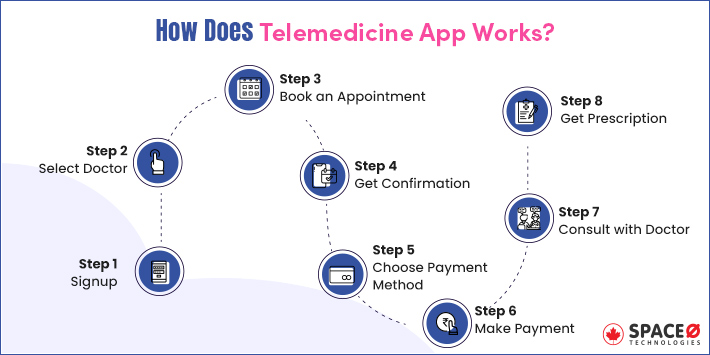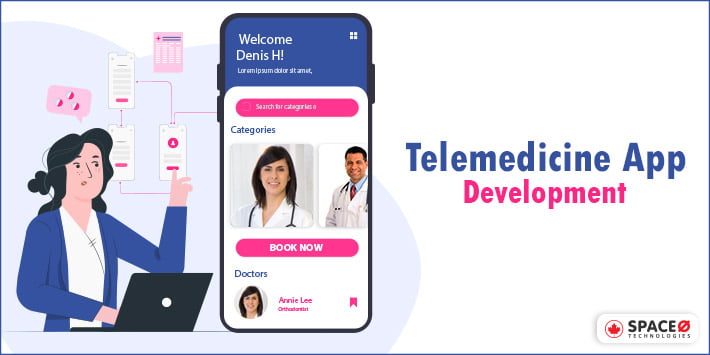Want to create a custom telemedicine app solution to streamline your day-to-day operations?
We know, after the pandemic, the telemedicine sector is rapidly revolutionizing using digital transformation. According to a report by Statista, the global telemedicine market size is going to reach a value of US 460 billion dollars by 2030.
As we have developed custom telehealth software for healthcare startups in Canada and the USA, we have experience in developing custom telemedicine solutions from scratch.
In this guide, you will learn a complete step-by-step process for telemedicine app development.
Read this guide to learn:
- The step-by-step process to develop a custom telemedicine app development from scratch
- How much does it cost to develop a custom telemedicine solution?
- Which are the core features required to develop a telemedicine application?
- How telemedicine app solutions are helpful to the healthcare industry
- How do monetize telemedicine applications?
Let’s get started.
Table of Contents
How Does Telehealth App Work?
A basic understanding of telemedicine apps is to provide healthcare services remotely to patients. Check the working process of the telemedicine app.

A telehealth app is a virtual platform where patients get consultations online. Through telehealth apps, the patients consult a doctor and request an offline visit if needed for further diagnosis.
Once the doctor approves the request, communicate with doctors either via video call or text. Then, receive the diagnosis and prescriptions. Afterward, your prescription is sent to the pharmacy and medicines get delivered to your door.
Looking for Custom TeleHealth Software Development?
Want to validate your telehealth app idea? Let’s talk.

Moving further, let’s check the telemedicine application development process in detail.
How to Build A Telemedicine App Platform in 6 Steps

As per the McKinsey & Company report, investment in telehealth almost doubled as compared to 2019.

Source: McKinsey.com
There is no doubt that investing in building telemedicine apps could be a good opportunity for healthcare startups.
Remember, the main purpose of telehealth app development is to provide convenience to patients who use this software as a service.
To develop a telehealth app solution, you need to hire reputed mobile app development firm who have prior experience in developing custom healthcare app solutions. With the help of experienced app developers, it becomes less hectic to develop a telemedicine solution from scratch.
But, before hiring an app development company, you must be clear with your requirements. That’s why the first stage comes from requirement analysis.
Requirement Analysis and Planning
Being a healthcare startup, the very first step toward building a telemedicine app is to conduct a business analysis and define the requirements for your project.
Additionally, as a telemedicine app deals with people’s health, you need to identify the patients’ expectations from your telehealth app. To do so requires analyzing the business needs and the target audience for your app solutions. The following points will help you to carry out market research.
- Define the audience of your telemedicine app solution
- Determine the purpose of your mobile solution
- Create a business strategy for your telehealth mobile application
- Identify and solve the challenges of your patients via the app
Depending upon that target audience, you need to develop your telehealth application. For example, your telemedicine app development might focus on one or more market segments of healthcare, such as healthcare providers, healthcare organizations, and government healthcare systems.
The business analysis looks forward to knowing your competitors and what they already offer to users. Then, based on your research, define your unique value proposition.
When you are clear with your requirements, it becomes easy to convey your expectations. Hire a mobile app developer and discuss your requirements. After that, the business analyst team will provide you with SRS (software requirement specification) and WBS (work breakdown structure). The SRS will also include the details on the features you want to include in your application.
Decide Features for Your Telemedicine App
To decide on the app features, you need to take the help of the Business Analyst team. Make a list of essential features you want to integrate into your telemedicine app. Here’s the list of features for the patient’s app and doctor’s app.
Telemedicine Software Features For Patients

The following app features will make the experience of patients smooth and satisfactory on a telehealth app.
Feature Name Description Audio/Video Conferencing This is to enable two-way communication via video between patients and healthcare providers. Some healthcare apps even allow screen sharing, so users join the virtual healthcare consultation and see each other. Audio/video session recording is one of the prominent features of such apps. Both doctors and patients are able to record it and download or view it later when required.
Chat Box This feature gives patients access to reach doctors via instant messaging. It could be for anything from advice to alarming situations. With a chatbox, the patient can discuss their health conditions with doctors anytime. Security Features From patient information to patients’ medical records, data protection on a telemedicine app is vital. Without end-to-end encryption, data security is impossible. For this reason, the patient app should have security features like encryption protocols and security protocols to protect and prevent the patient’s sensitive data from getting compromised.
Virtual Waiting Room For an excellent account user experience on your mobile telemedicine app, install a virtual waiting room. Such customized features allow seeing where they are in the queue, how much time their appointment will begin, and when the video chat will start on the patient side. Plus, this feature helps doctors in time management. Appointment Scheduling Every telehealth app should have an appointment scheduling feature. In addition, patients must be able to log in by themselves to manage appointments according to a convenient and available time slot. Payment Telemedicine applications without integrating payment gateways are incomplete. Integration of a payment gateway allows patients to make payments for consultations or visits. It’s also beneficial for users to check the previous transaction history of payment. Though telemedicine works for both doctors and patients, its features differ. While patients demand online consultations, the doctor app should have features and functions to fulfill these demands. The following are the main doctor app features:
Telemedicine App Features For Doctors

Let’s check out the features of the doctor’s telemedicine application.
Feature Name Description E-prescribing Can you imagine a doctor and a prescription individually? You know the answer. That’s why a telemedicine platform should have e-prescribing features. Through this app, healthcare specialists should be able to send prescriptions directly to patients, their pharmacies, or family members’ devices. Clinical Documentation This feature is unavoidable for both patients and doctors/physicians. Clinical documentation permits uploading a patient’s clinical details like medical tests, x-rays, trials, or treatments they have undergone. Without proper clinical documentation, authenticated diagnosis is impossible for any health condition. Real-Time Tracking For a smooth-going e-medical process, real-time tracking is a must. Doctors should know who the upcoming patient is before the consultation starts for proper time management and patient management. Plus, real-time tracking provides all information about how many patients are consulted, how many patients are left, and how much time the next patient will arrive.
Communication Abilities A feature with communication abilities helps doctors interact through HIPAA (Health Insurance Portability and Accountability Act) – compliant messaging. Nothing should hinder them while facilitating authorized users with a patient’s electronic protected health information. (ePHI) Easy Access This doctor app feature lets doctors have access to the patient’s medical records from the telemedicine system and offer health solutions with the best healthcare products. Also, it has integrated access to pharmacy databases. Besides this, the feature should give the doctor on demand easy access to documents like CT scans and lab test results for further diagnosis. Analytics Support One of the essential features from the doctor’s end in a telemedicine app is analytics support. On entering data into the software, a doctor must get an analysis of the patient’s current situation. On this basis, he can make changes or make improvements in future consultations. A telemedicine app for doctors with analytics support can create wonders in the medical field. Integration of EHR System Adding this feature is beneficial for doctors, it allows doctors to see the electronic health records of patients. So, doctors get to know about the previous health records of patients. This helps to avoid any issues that can cause serious health problems to any patient. Create Wireframe and UX/UI Design
Once the market analysis and features are decided, then you start designing the app’s UX and UI. To offer a great user experience, it is always advisable to create a wireframe of your telemedicine app. Once the wireframe is finalized, moving ahead with designing UI/UX becomes easier.
A better user experience and user interface of any app mean the best app look. The telemedicine app’s layout and navigation should be in accordance with its concept and the perception of the target audience.
Development of Your Telemedicine App
At this stage of telehealth app development, the mobile application development team will build the first version of your telemedicine app solutions. It includes all the functions and features as per your requirements.
This development integrates different APIs, such as a payment gateway, video calling, and chat/messaging, into your app, so patients can pay the fees online per doctor consultation. Of course, you can build a full-fledged application, so it has all the necessary functionalities that are useful to telehealth app users.
Quality Assurance and Testing
While developing a telemedicine app, quality assurance plays a pivotal role. The testing process makes sure that the app’s user experience and user interface are proper, its development approach is correct, the layout is as per standards, performance is good, there are no bugs, and the end quality of the app is appropriate.
Launch of Your Telemedicine App Solution
The last step of building your own telemedicine app is to launch it. Depending on its functionality, you have to make your app live on the Google Play Store or iPhone Store, or both.
To launch your telemedicine app in the market, your app development team will ensure that your app meets the standard of app stores. So, it doesn’t get rejected from app stores.
After launching it, you must advertise and promote the use of your app through several mediums and advertising app offers. Also, take care of your marketing expenses while promoting.
This was all about the process of developing a telemedicine application. Now, you might be wondering about the cost to develop a telehealth app.
Want to Hire a Professional Mobile App Development Team?
Based in Canada, we are a professional mobile app development company. Get a free consultation to discuss your telehealth app requirements.
How Much Does It Cost to Develop a Custom Telemedicine Application?
There are several factors involved in project development that includes designing, wireframing, software development, building, and launching; everything is cost inclusive.
In addition, the costs of developing a telemedicine application depend on the features you want to include, the location of app developers, complexity and development time. If you build a simple-designed app, the app cost will be the least.
However, if we build an advanced app, the cost will range higher depending on the features. For instance, if you decide to remove the online prescription option from your app, the cost would be cut down for that feature.
Certainly, to get the exact cost for your telemedicine app idea, get in touch with a reputed app development company. So, what could be the advanced features that might increase the cost of development?
Advanced Features in Telemedicine App Development
Notification Reminders
Most of us forget to take our medicines on time in busy schedules, such as reaching our scheduled appointments and carrying out many smaller tasks like drinking water. A useful feature for healthcare on-demand apps would be allowing users to set reminders. This feature would be useful for both patients and doctors.
Patients can set up reminders for tasks such as drinking water, taking medicines, going for a walk, and eating healthy. On the other side, doctors can use it to remind them of any upcoming surgeries, events, and appointments they may have. This will not only help people stay healthier but will also ensure that they form better habits and stick to them.
Send Alert of Emergency to Near Hospitals
It’s important for patients with chronic illness to have someone they can reach out to in case they need help. For this reason, as a leading iOS and Android app development company, we help you make a doctor on-demand app that helps patients reach out to someone in need.
We help you set up emergency numbers in the mobile app, the numbers of the patient’s doctors or family and friends. This feature will also be helpful for many people who are not terminally or chronically ill either.
By using the emergency case option, users avail themselves of first aid services when needed. It also saves lives in cases of fire, car crashes, and other disasters.
Past Medical Records
If the patient contacts when he or she is sick, it takes some time for the doctor to understand exactly what the problem is or how it could have occurred. However, if the doctor had a record of the patient’s past medical history, it would be much more convenient for them to study it and gauge the cause.
To integrate this feature into your doctor’s on-demand mobile application, you will need to provide cloud-based e-storage to all the patients. They can upload data about their past medical records in the cloud and provide access to the doctors that they are consulting. It will be very useful for patients too since they won’t have to lug all their files around for every consultation.
Availability of Professional Doctors 24/7
In a big network of licensed and professional doctors that are available 24/7 is a must-have feature in your doctor on-demand application. A big network of doctors allows patients to choose from the best and most professional doctors by category.
The patient can have a look at different doctors and physicians by category and choose one that matches their needs. The app connects users to a doctor in just minutes, anytime 24/7, so they can start taking consultations to feel better, faster.
So, if you as a healthcare startup have planned to develop a mobile app like Uber for doctors, make sure that you allow patients to choose from the best available doctors.
Sick Notes
People sometimes have to skip school or work due to sickness. However, it is necessary to provide sick notes to ensure that you do not suffer any losses, be it an exam at school or a day’s pay at work. So, users don’t need to worry about sickness proof.
For example, users of the Maple healthcare app don’t need to worry about this at all. The users just have to tell the doctor what they need and why, and he will write a note that you can print and submit.
Next, know the current trends used in telemedicine app development and find the seven top-notch technologies to develop a telemedicine app.
Advanced Technologies Used In Telemedicine Apps

Artificial Intelligence
AI has set its foot in every sector, and the healthcare industry is no exemption from it. AI is nothing but making machines that can perform human-like functions. Therefore, you can use it in the medical sector. There are three major uses of AI technology in telemedicine app development:
- Chatbots – These are the online group chats carried between a patient and healthcare professionals. Some chatbots even have voice recognition features in them. Often, the next step is to book a doctor’s appointment.
- Diagnostics – Using Artificial Intelligence in diagnostics means understanding a patient’s case through video conference software. AI improves the overall quality of diagnostics.
- Prevention – With Artificial Intelligence, the general tasks of doctors can be automated. Hence, it prevents unwanted workload.
IoT (Internet of Things)
The Internet of Things is one such technology that telemedicine apps need today.
The most significant benefit of using IoT is that it stores the patient’s big data.
These platforms store data and send a report to the doctors later on.
For example, mobile app categories like fitness trackers, walk trackers, and pulse trackers use IoT technologies.
AR/VR Technology
Offering personalization has become a mandatory approach in every field. AR/VR technologies have helped designers a lot in delivering personalization through telemedicine apps. Users get convinced easily with augmented reality and virtual reality examples. VR technologies can revolutionize the use of tools in diagnosing patients.
In video consultations, the 3D elements of VR technology enhance the final results. However, because of poor video quality, it ruins the purpose. Similarly, AR technology also benefits in its unique ways. For example, by using it right in the app development, doctors can operate on the case more realistically through a telemedicine app. In short, AR/VR technologies give oxygen to virtual medications and make them live.
Blockchain
A telemedicine app uses video and voice integrations to transfer the patient’s data to the doctors.
Blockchain technology ensures and encrypts the user data from any kind of breach.
Blockchain technology answers all the concerns regarding the security of telemedicine app development. The exchange of information guarded by Blockchain cannot get damaged otherwise.
Cloud Storage Technology
It’s only because of cloud service solutions that the data is revolutionarily stored today.
According to ResearchandMarkets, the global cloud computing size will reach $947.3 billion from $445.3 billion by 2026.

Image Source: ResearchandMarkets.com
Cloud technology allows data storage to multiple devices from anywhere in the world and has even impacted the telemedicine sector.
Several telemedicine apps have cloud-based electronic health record systems. These EHR (electronic healthcare records) systems manage, store, and allow users to access critical medical information. Critical data like lab-test progress results, prescriptions, and a patient’s medical information need multiple layers of security, which is possible only with cloud storage technology.
Check out the complete guide on cloud-based application development and find out the benefits, challenges, and processes to develop one for your telemedicine startup.
Data Analytics Technology
Telemedicine apps and gadgets generate a pool of patient and doctor data daily. This data is in the form of reports or lab results stored by wearable devices like smartwatches and smart devices used in the healthcare industry.
Using big data technology, telehealth apps can analyze this data, use it to conduct research, and conclude with solutions. They can use this data to understand the patterns of people’s health on various parameters and improve the service of the industry with a good development rate. Also, data analytics help in modifying the telemedicine app development models.
Remote Monitoring
Remote monitoring has become an inseparable asset of telemedicine. Most telemedicine-related transactions are part of remote patient monitoring. The coronavirus pandemic has already made us realize the importance of virtual healthcare and its future expansion.
Doctors also prefer remote patient monitoring tools (RPM) because this way, they can diagnose patients without actually contacting them. Remote patient monitoring devices also help in real-time monitoring, and doctors can make well-thought decisions based on them.
With the new 5G technology, remote monitoring is yet to boom more and more in the upcoming future. That’s why remote monitoring is considered the best telemedicine solution.
What are the advantages of developing a telemedicine app? Let’s check out.
Benefits Of Custom Telemedicine Solution for Doctors and Patients
A telemedicine app development solution not only benefits doctors and patients but also clinics and hospitals. In this list, we’ve tried to cover most of its many merits. For a better understanding, we have pointed down its benefits one by one.
| Benefits for Patients | Benefits for Doctors |
|---|---|
| With a telemedicine app, there is no compulsion to visit the clinic. You at remote locations, outskirts, and secluded regions can even get a doctor’s advice. This saves the travel time and time you spend at the doctor’s clinic. | A decrease in the number of patients walking into the clinic for physical check-ups. It avoids the spreading of contagious and chronic diseases. With an app, they have reached greater regions and a large pool of patients virtually. |
| Using a telemedicine app saves a lot of time for patients. Patients need not stand in queues or sit in waiting rooms. This will indeed make telemedicine more feasible. | Doctors can save time from individual visiting and can attend to more patients virtually. Healthcare providers can be deprived of personal visits. |
| Although, a telehealth services app is perfect for use in case of regular-life behavioural health concerns or follow-ups. Also, the telehealth app is the best medium to use for consulting any ill effects that you are suspicious about. | No need for keeping manual records. It helps to maintain records efficiently. Doctors can access any patient-related information through the app. |
| Patients get easy access to particular healthcare specialists. So, they don’t need to travel a long way to get treatment for particular diseases. | A telemedicine app allows doctors to avoid documentation work. You can save both your time and effort from filling out forms, documentation and other formalities if you use an app, instead. |
Telemedicine app development has multiple benefits, we agree. From regular check-ups to chronic disease monitoring, you can do it all. However, we would recommend no one use telemedicine for urgent care conditions like a heart attack or cardiac arrest; instead, visit your nearest care provider.
What are the ways to monetize your telehealth mobile applications?
Monetization of Telemedicine Solutions
The following three strategies or, say, monetization models will help you monetize your telemedicine application. Read them all and pick the best one for you.

Offer Fremium Model to Your Users
Not only telemedicine applications but most of the iOS and Android mobile health apps use this strategy for monetization, an app design with a free + premium version. The free version offers basic usage, while the premium version delivers advanced functionality. This is one of the trending revenue streams used by famous apps. For example, Doxy.me is the best app to consider in the freemium model.
Commission-based Model
You can charge registration fees from the doctor to use your software. Whereas you can charge subscription fees from the patient to use your medical services, create a user profile, and per doctor consultation. You can even charge a subscription fee based on the consultation duration. This is a two-way monetizing strategy for your iOS or Android telemedicine mobile app. For example, Maple is one of the apps that charge subscription fees.
Promotional Discounts
Any app that gives promotional discounts is the king of the telehealth business. For instance, the app user should get a discount on the X-ray report in an ‘XYZ’ lab during his/her next visit. Thus, offering promotional discounts to users via Android or iOS apps helps to get monetary benefits for you and other brands as well.
We already know the technologies used for developing a telemedicine app. Now it’s time to know which businesses and their development partners are already reigning in the telemedicine app world.
Examples of 7 Best Telemedicine Applications
These apps are already available on the app stores and work both on iOS and Android. We have listed these apps based on the app store’s rating and usage in the Canadian region.
| App Icon | Description |
|---|---|
 | Maple connects you with licensed Canadian doctors and healthcare consultants around the clock 24/7. You get visits at a starting pay of $45. It offers various options like chat, audio, or text to connect with doctors. You get full medical consultation services, including diagnosis to prescriptions to cure the diseases. Getting treatment on Maple is an easy three steps process; describe symptoms, chat with a doctor, and get yourself diagnosed and prescribed. |
 | Competent to run on any browser, Doxy Me is a simple-to-use telemedicine application. In this app, the doctor from anywhere just clicks their personalized room link and joins with the patient for a video call. It is configured with both EHR (Electronic Health Records) and PM (Practice Management) software. Besides the free basic version, the app has premium tiers, too. |
 | AMC health app provides FDA-approved healthcare services. It allows Bluetooth connectivity and biometric data transfer. It is a fully advanced-featured app with remote operations and personal dashboard options. The Bluetooth function allows BP monitors, oximeters, glucometers, thermometers, pulse trackers, medication trackers, and similar devices for a wireless connection. It provides virtual care solutions that help to improve patients’ health. |
 | The Doctor On Demand app has earned 4.9 ratings on both Android and iPhone. The consultants on Doctor On Demand are registered members of the medical industry. You can cure your conditions after consulting Doctor On Demand apps’ psychologists, physicians, and psychiatrists. The Doctor On Demand will collect your data, run a test, and suggest a treatment to be done. Bonus benefit – Doctor On Demand is a free app. |
 | MDLIVE app is the best for consulting a healthcare provider when your primary physician is unavailable. Mainly, the app covers pediatricians and behavioural therapists on the list of doctors. You can also enroll in an appointment with a psychiatrist whenever needed through the MDLIVE app. It offers behavioural health appointments with licensed therapists & board-certified psychiatrists. |
 | Lemonaid app comes with a free version for all its basic features. On paying $25, it assigns you a doctor and his/her paid consultation. You need to select a service and answer a few questions related to it. You’ll receive your diagnosis within 2 hours through the app only. If needed, you may even receive immediate doctor consultations through video calls. |
 | Teladoc is one of the top telehealthcare apps in the USA and Canada. It is one of the best on-demand doctor apps available in the market. You get 24/7 access to Canada-licensed doctors. The Teladoc app is accessible via the web as well as via an app. If you have general insurance, you get visits as low as $0. And if you don’t have general insurance, then you cost $75 per visit. |
Still, looking for more information on telemedicine apps? Check out the most frequently asked questions to find answers.
Want to Know Exact Timeline for Telemedicine Software Development?
Let’s talk. Get a FREE consultation from our app consultants. We have a team of experienced Android and iOS app developers to convert your vision into reality.
FAQ About Telemedicine App Development
What technologies are most used in telemedicine apps?
- Artificial Intelligence for treatment recommendation
- Internet of Things (IoT) for patient monitoring
- Big Data to improve the health record systems
What is the major difference between Telemedicine and Telehealth?
How to monetize your telemedicine app?
- Pay-per-visit Model: It allows you to charge patients for scheduling an appointment with a doctor.
- Subscription Model: It allows you to charge patients to get healthcare services as well as doctors to provide a virtual platform for consulting.
- Premium Membership Model: This model allows you to offer premium healthcare services, such as getting immediate consultation, and medicine within a limited time.
Which are the core features of the telemedicine app?
- Patient portal
- Video chats
- Chat option
- Appointment scheduling
- Medicine tracking
- Appointment history
- Access to medical records
Which regulators do you need to consider before developing a telemedicine app?
- ISO
- GDPR
- HIPAA
- PIPEDA (Canada)
Where can you find the telemedicine app developers?
- Space-O
- Upwork
- Toptal
- PeoplePerHour
Some of the technologies considered in telehealth app development process apps, such as
Telehealth is a broader term than telemedicine. Telemedicine visits concern only healthcare services, and it’s a part of the telehealth solution. However, the telehealth platform includes healthcare and non-healthcare services. It comprises telemedicine, telehealthcare, and e-health/education.
One can monetize the telemedicine app by adopting the following models.
Here’s the list of core features that help you to the MVP version of the telemedicine mobile application.
Here are the places where you are able to find app developers for apps for health services.
Develop Your Telemedicine Software Application
We’ve covered all your concerns related to the telemedicine app development process, its cost, features, and technologies. If we still miss anything, you can ask us or comment below to contact us. If it is difficult to build a quality and strong telemedicine app on your own, you can contact a telemedicine app development company.
We will help you to know the exact mobile app development cost and timeline. Get in touch with us. With the experience of developing over 300 custom mobile apps and web solutions, we are a prominent mobile app development company in Canada. We create result-driven custom applications for businesses around the world.
 By
By 






